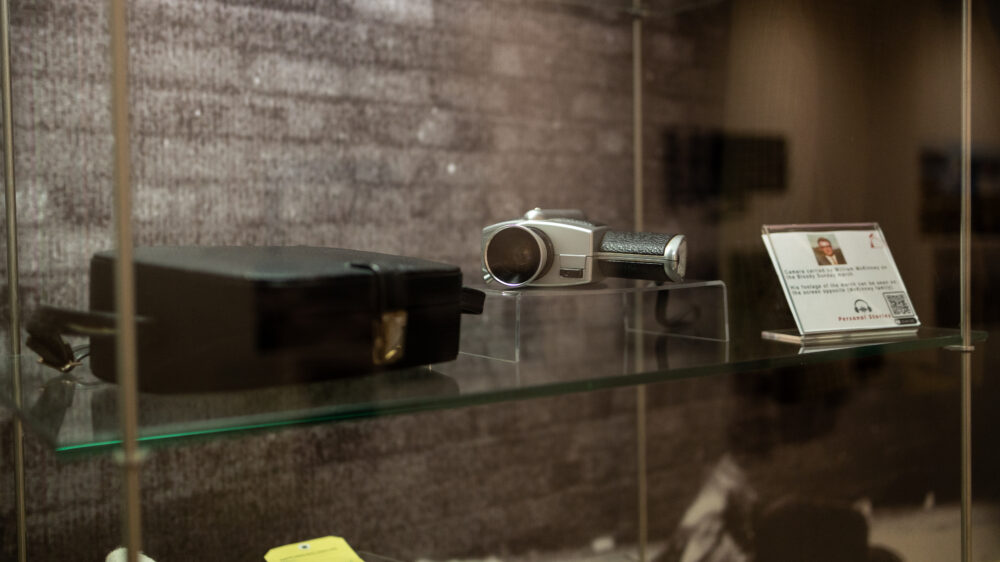
LONDONDERRY, Northern Ireland — On a late Sunday afternoon in January 1972, 27-year-old William McKinney slung a new movie camera over his shoulder and draped a rain jacket over his arm as he walked out of his home. He was on the way to document a Catholic civil rights march just a few streets down into Londonderry’s Catholic neighborhood known as the Bogside. McKinney’s mother stood in front of their home with her youngest son, 8-year-old John, who cried out to his big brother, begging to go with him. “I hope nothing happens to our Willy,” their mother said.
“I remember me and my mother stood at the front door, and we watched him walk right down to the bottom of the street until he just disappeared,” John McKinney told me in an interview. “That was the last time I seen him alive.”

William McKinney was among the 13 unarmed people killed and at least 15 people wounded, one of whom later died from his injuries, that day by British soldiers who fired into the crowd of 18,000 civilians participating in the march.
The day became known as Bloody Sunday, and the victims’ families have been fighting for justice for their loved ones ever since. Over the past 53 years, the British government has declared all victims innocent and has not held any of the soldiers accountable, until now.
At the end of March, the government announced that one of the British soldiers who allegedly participated in the shooting will stand trial in September for two charges of murder for the killing of William McKinney and another march participant, James Wray. The suspect, publicly named only as “Soldier F,” also faces five counts for the attempted murder of Patrick O’Donnell, Joseph Friel, Joe Mahon, Michael Quinn and an unknown person. In December 2024, Soldier F pleaded “not guilty” to all seven charges.
The trial date is a small victory for the victims’ families, who have spent the last five decades fighting for justice and speaking publicly about their loved ones. For John McKinney, it’s a mission that’s encompassed most of his 61 years. He leads tours of the march path, and along with the family members of other victims, works at a museum dedicated to the massacre.
I visited McKinney in Londonderry (also known as Derry) just one week before the court announced the trial date. He recalled the morning his life took a drastic turn. While his five brothers and three sisters attended the march, McKinney played football with his friends on a big green lawn outside his house, like they did every day. That’s where they first heard the gunshots. They all knew something was wrong, but he put it out of his mind until that evening, when he was in his family’s living room and some people from the community walked in.
They said, “‘People have been shot dead at the march,’” McKinney recalled. Their neighbor, Pat Clark, was the first to tell his parents that William had been shot. When more people began to fill their house, his father left to go to the hospital. “We had a really small house, and our house was packed with people, so obviously we knew that something was wrong,” said McKinney.
One by one, each of the McKinney children came home, except for William. When his father arrived at the hospital, he was told he needed to go to the morgue.
Justice for some
The families of those killed on Bloody Sunday have banded together to seek justice for their lost loved ones. Many, however, will never get the opportunity to do so in court. Some of the soldiers have died of old age and other cases lack sufficient evidence. For that reason, explained McKinney, it was all the more important that he remained committed to following the case of his brother’s suspected killer. “If we get him prosecuted,” he told me, “it will be some justice for the rest of them as well.”
McKinney was in his early 20s when he began helping with the campaign to get justice for the Bloody Sunday families. Each year on the anniversary of Bloody Sunday, thousands gather together at the Free Derry Wall and march in remembrance of those killed and injured that day.
One of the family members usually reads a statement on behalf of all the families. McKinney recalled the first year he was asked to read. He was reluctant, because at 32 years old, he had a stutter when speaking publicly. But his sense of purpose prevailed.
“I remember when I stood up in front of those 20,000 people, I didn’t have a stammer, and I read three pages of a statement,” he said. “I was very proud of myself when that happened, very, very proud, and I couldn’t wait to get back to the house to tell my mother as well.” That moment led to McKinney’s career of sharing the story of his brother and other victims with the public.
McKinney now has a full-time job running “The Troubles Bogside Walking Tour,” which aims to tell visitors the truth about what happened on that day 53 years ago. I joined him for a tour in Londonderry this March. As he shared the history of Bloody Sunday, he led the group through a car park surrounded by small homes, to the gray brick sidewalk that lines the wall of the museum and curbs into the parking lot.
“Four people died here in this car park, and this is where my brother was killed,” he said, standing in the spot where William lay after being shot.
McKinney said he still gets emotional when he talks about his brother on the tours, but wants as many people as possible to hear the story of each person killed on Bloody Sunday. Without fail he lists each of their names on every tour.
“It’s a story that has to be told, and if that means that I know that I suffer, I don’t care,” he said. “I’ll take my suffering as long as I get the story out there, and that’s why I do the tours.”
In 2007, the families opened the Museum of Free Derry, which displays memorabilia from the march and educates visitors about the events of Bloody Sunday and the people who were killed or injured. The museum is in the Bogside, next to Glenfada Park, the car parking lot where William McKinney and Wray were killed. Film footage of the civil rights march taken by William McKinney’s movie camera has been made digital and plays on a loop at the museum. His camera is also on display.

Jean Hegarty, whose brother Kevin McElhinney was killed on Bloody Sunday, also works at the Museum of Free Derry. When I met Hegarty, we walked outside the museum, and she pointed to some brick row houses nearby. Each of the houses looks similar, but one stands out with its white door, and white trim around the bay window. A short brick fence surrounds the porch and a small grass area. This is the house her brother was crawling to for safety when he was shot by a British soldier, Hegarty told me.
On Bloody Sunday, Hegarty, who is now 76 years old, lived in Canada. She moved back to Londonderry in 1996 and devoted her efforts to educating people about Bloody Sunday. There is not enough evidence to prove which soldier killed her brother, she said.
Hegarty said she is happy someone will be held accountable for the deaths of some of the victims, but she wonders why some families may receive justice and others will not.
“I think it’s something I can live with,” Hegarty said, although “I don’t know that it’s something I don’t have a degree of resentment about. But the resentment I would definitely not think is with the McKinney family; the resentment would be with the British army and the security forces.”
Hegarty shows her support for the McKinney and Wray families by attending the court hearings as often as she can. “I don’t know why I’m a bit obsessive because you’re in the court for five minutes,” she said, “but part of that is, I feel it’s a bit of loyalty to Kevin.”
Protection for Soldier F
Another point of contention for the victims’ families is that the suspect’s identity continues to be kept confidential, due to an interim court order to protect him because he could be at risk of a targeted attack if he is identified.
At court hearings, Soldier F is concealed behind a screen and people are barred from revealing his identity or speaking his name. McKinney and the Wray family have fought against concealing Soldier F’s identity because they have seen him in person during the public inquiry, and many people already know his identity, McKinney said. They lost that battle, but others are pushing back by naming who they claim Soldier F to be as an act of resistance.
On July 13, 2021, Colum Eastwood, Member of Parliament of the United Kingdom, using his parliamentary privilege in the House of Commons, said, “Almost 50 years ago 14 unarmed civil rights marchers were murdered on the streets of Derry by the Parachute Regiment. Five of those victims were shot by David Cleary, otherwise known as Soldier F.”
In the weeks before Eastwood’s remarks, Londonderry residents showed solidarity with Eastwood on social media, and in signs posted around Londonderry that read “Soldier ‘F’ is Dave Cleary. No more anonymity.”

As the trial date nears, McKinney continues to struggle with balancing his mission and mental health. He jogs on a treadmill and listens to Phil Collins and Genesis to clear his mind of the memories he dredges up each day on tours. But he’s not yet sure how to mentally prepare for the potential of the worst outcome — a “not guilty” verdict after a lifetime of waiting.
“Bloody Sunday happened in 1972, and I was just 8 years old,” he said. “I’m now 61 and that’s how long we’ve been waiting on a trial.”
